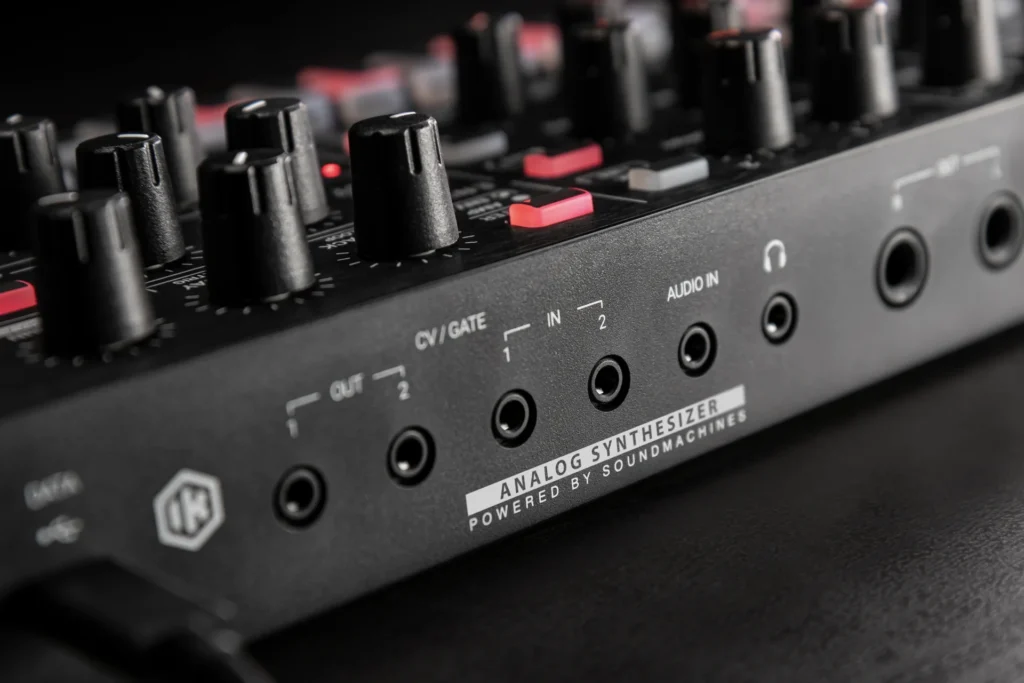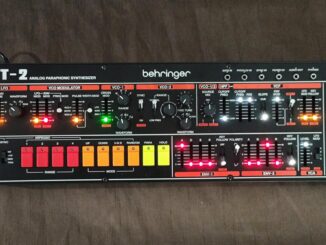IK Multimedia takes its paraphonic analog UNO engine to the next level in the new UNO Synth Pro X, by making it more accessible and versatile.
The UNO Synth Pro polarized right from the start. Mainly because of the unusual design and unfavorable matrix layout. It contradicts the image of a classic analog synth: to be direct, hands-on, and fun-to-tweak. It isn’t all that. However, the engine is the complete opposite. It’s one of the finest and fattest sounding modern analog engines on the market today.
IK Multimedia has noticed the criticism and shows the reaction to it with the new UNO Synth Pro X.
Details
UNO Synth Pro X is a new desktop analog paraphonic Synthesizer. Desktop only, no keys version. It is currently unclear whether the latter will come in the future. IK uses an old familiar shape for the X, which is slightly wrapped and rounded at the corners.
The knob sea catches immeatly the eye. Where the Pro has 8 knobs, the Pro X packs 23 knobs and lots of buttons on the front panel. There is also a one-octave keyboard and a sequencer with large keys on the bottom.
The unpopular matrix is history. Now everything is done with knob per function, switching or via shift combinations. Very deep functions are still controllable via the display and respective encoder.
Revised And Boosted UNO Synth Pro Engine
The analog engine of the UNO Synth Pro was able to fully convince with a fat, characterful, juicy sound with lots of depth. IK probably thought the same thing and took over the engine from the Pro, but refined and expanded it with new goodies. On the feature sheet, it’s not a revolution; it’s a small but good evolution.
Like the Pro, the UNO Synth Pro X features three morphing analog oscillators with continuously variable shapes. You can morph between triangle, sawtooth, square, and pulse waves.
Again no dedicated PWM knob but you can achieve it via the morphing. The built-in FM and ring modulation options can add more harmonic content to your sound. Hardware parameters are available for many functions of the oscillators (wave, tune, level…). Hidden behind a quick and easy-to-reach shift combination is a noise generator. So three oscillators and noise form the oscillator block.
From here, it goes right in the excellent dual analog filter architecture. Like in the Pro, you can find here the original UNO OTA-based multimode filter and a 2/4 pole SSI LP filter with self-oscillation. The dual filters can be used in series and parallel, with invertible phase, for a total of 24 possible filter combinations.
Massive Modulation Engine
Modulation side, you can benefit from three instead of two super-fast envelopes, expanded in the X with loop function and retrigger options. There are also two LFOs with fade-in, and retrigger options as well.
A 16-slot matrix, each with 38 mod sources and 52 mod destinations, again manages the modulation of the UNO engine, with unique sources and destinations like the filter cutoff and resonance as modulators. This gives musicians massive sound design possibilities. BTW, by removing the amplitude modulation (AM), you can turn the UNO into an excellent drone synth.
Hybrid Effects
The dual filter engine sends the signal directly into the multi-effects engine. This is hybrid and almost identical to the UPro. It starts with a super warm analog overdrive and is followed by three digital FX slots.
In the modulation part, you can find two flavors of chorus and an ensemble effect. The delay and reverb come in various types, including stereo and ping-pong delay, and the reverb comes with an all-new shimmer reverb. Additionally, you can route external signals through the effects with pre-effects filtering.
Sequencer
The arpeggiator and sequencer are also included in a revised form. All two functions are much more user-friendly thanks to the new interface. The arpeggiator has a veritable bouquet of different directions (up, down, up/down, up/down +…) accessible from the hardware. This can also be recorded back into the sequencer.
Yes, the same 64-step sequencer is back, with LAST step function and with parameter automation of up to 48 parameters per step. You can also work with accent and tie. Plus, there is a randomizer allowing to create of instant new sequences.
Bassline Mode
A UNO Synth Pro X highlight is hidden behind the Bassline button. Here you turn USPX into a 3-oscillator, dual-filter bassline synth with the parameter behavior of the Roland TB-303. Not a 303 sound emulation!
Once activated, the cutoff and envelopes get limitations in ranges or controls. The ADSR envelopes become AD envelopes with additional accent and accent decay controls.
Connectivity
On the back, almost everything has remained the same. It now offers a USB-C port for data transfer and power, no longer micro USB, DIN MIDI In/Out, 2x CV/gate in/out ports, balanced 6.3mm stereo outputs (L/R), and a power supply input. So you are no longer forced to use the noise-prone USB port.
In 256 slots, you can save your presets. Each preset consists of the sound and the sequencer. However, when loading, you can choose whether you want to load only the sound or both.
If you need digital support, no problem. IK Multimedia includes an editor that comes as a standalone version and plugin for macOS and Windows. Here you can edit parameters and import and export patches. A downer is that you can’t edit sequencer data in the editor.
First Look – In Use
And the USPX has been in my studio for a little over 2 weeks. The “ugly duckling” has become a beautiful, performance-oriented Synthesizer. The redesigned knobby interface is already noticeable after a few minutes with the new USPX.
Core elements like the oscillators, filters… are now in front of the eyes and can be directly adjusted with the fingers. It’s fun to tweak parameters like on a classic analog Synthesizer.
The sound engine still has the same strengths: juicy, full of character, and with a lot of low-end, just like the UNO Synth Pro. And thanks to morphing, dual filtering, and parameter automation in the sequencer, the analog sounds go far beyond those of classic vintage synths.
A third envelope and loop option are handy extras, allowing even more modulations. The sequencer is maybe still in its infancy and needs to be improved. For example, there is no option to adjust the time division of the sequencer. This is currently possible with an external clock from another device. And this is also a bit shaky. A mute function for individual steps is also not available.
Further, a hold function for the shift function would be nice and some bugs need to be fixed. Nevertheless, the Uno Synth Pro X is a very good further development of the first USP. It’s a “synth redemption” that appeals to more users than the first generation, I’m pretty sure.
IK Multimedia UNO Synth Pro X is available now for an official price of 609,99€ and at retailers for 589€.
More information here: IK Multimedia
Available at my partner









Not bad, not bad! But with all the filter options, FX, sequencer and CV/Gate connectivity, an input for external audio could have made it a pretty complete package.
Oh I’m sorry, it has an Audio In, nice!
Same old formula, make it X or Black, in this case both with some knobs. Why small is better?! By the way, they made the promo clip recording thru a cheap Zoom digital mixer 😳. That says everything about their pro line
I think this is a big step up from the other UNO’s.
Credit to IK.
If it was a poly synth I would definitely consider it. I have too many mono / paraphonic synths!
I like the styling though. Reminds me very much of the Access Virus C.
An onboad Sampler would have been nice